Seasonal and Decadal Groundwater Changes in African Sedimentary Aquifers Estimated Using GRACE Products and LSMs
Abstract
1. Introduction
2. Materials and Methods
2.1. Groundwater Basins in Africa
2.2. ΔTWS and ΔGWS Estimates from GRACE and Land Surface Models (LSMs)
2.3. Statistical Methods
3. Results and Discussion
3.1. ΔTWS Patterns Across the Major Aquifer Basins in Africa
3.1.1. Seasonality of TWS Changes
3.1.2. Long Term Patterns in TWS
3.1.3. Differences between GRACE Products
3.2. Estimated GWS Patterns across the Major Aquifer Basins in Africa
3.2.1. Seasonality of Estimated GWS Changes
3.2.2. Long Term Patterns in Estimated GWS
4. Conclusions
Author Contributions
Acknowledgments
Conflicts of Interest
References
- Döll, P.; Hoffman-Dobrev, H.; Portmann, F.T.; Siebert, S.; Eicker, A.; Rodell, M.; Strassburg, G.; Scanlon B, R. Impact of water withdrawals from groundwater and surface water on continental water storage variations. J. Geodyn. 2012, 59–60, 143–156. [Google Scholar]
- Vörösmarty, C.J.; Douglas, E.M.; Green, P.A.; Revenga, C. Geospatial indicators of emerging water stress: An application to Africa. Ambio 2005, 34, 230–236. [Google Scholar] [CrossRef] [PubMed]
- Taylor, R.G.; Scanlon, B.; Döll, P.; Rodell, M.; van Beek, R.; Wada, Y.; Longuevergne, L.; Leblanc, M.; Famiglietti, J.S.; Edmunds, M.; et al. Ground water and climate change. Nat. Clim. Chang. 2013, 3, 322–329. [Google Scholar] [CrossRef]
- MacDonald, A.M.; Calow, R.C. Developing groundwater for secure rural water supplies in Africa. Desalination 2009, 248, 546–556. [Google Scholar] [CrossRef]
- Hunter, P.R.; MacDonald, A.M.; Carter, R.C. Water Supply and Health. PLoS Med. 2010, 7, E1000361. [Google Scholar] [CrossRef] [PubMed]
- Konikow, L.F. Contribution of global groundwater depletion since 1900 to sea-level rise. Geophys. Res. Lett. 2011, 38, L17401. [Google Scholar] [CrossRef]
- Wada, Y.; Lo, M.-H.; Yeh, P.J.F.; Reager, J.T.; Famiglietti, J.S.; Wu, R.-J.; Tseng, Y.-H. Fate of water pumped from underground and contributions to sea-level rise. Nat. Clim. Chang. 2016, 6, 777–780. [Google Scholar] [CrossRef]
- Shiklomanov, I.; Rodda, J. World Water Resources at the Beginning of the Twenty-First Century [International Hydrology Series, UNESCO]; Cambridge University Press: Cambridge, UK, 2003; 417p. [Google Scholar]
- Longuevergne, L.; Scanlon, B.R.; Wilson, C.R. GRACE hydrological estimates for small basins: Evaluating approaches on the High Plains Aquifer, USA. Water Resour. Res. 2010, 46, W11517. [Google Scholar] [CrossRef]
- MacDonald, A.M.; Bonsor, H.C.; Ahmed, K.M.; Burgess, W.G.; Basharat, M.; Calow, R.C.; Dixit, A.; Foster, S.S.D.; Gopal, K.; Lapworth, D.J.; et al. Groundwater quality and depletion in the Indo-Gangetic Basin mapped from in situ observations. Nat. Geosci. 2016, 9, 762–766. [Google Scholar] [CrossRef]
- Calow, R.C.; MacDonald, A.M.; Nicol, A.L.; Robins, N.S. Ground Water Security and Drought in Africa: Linking availability, access and demand. Ground Water 2010, 48, 246–256. [Google Scholar] [CrossRef] [PubMed]
- Lawrence, A.R.; MacDonald, D.M.; Howard, A.G.; Barret, M.H.; Pedley, S.; Ahmed, K.M.; Nalubega, M. Guidelines for Assessing the Risk to Groundwater from On-Site Sanitation; British Geological Survey Commissioned Report, CR/01/142; British Geological Survey: Nottingham, UK, 2004. [Google Scholar]
- Pritchard, M.; Mkandawire, T.; O’Neill, J.G. Assessment of groundwater quality in shallow wells within the southern districts of Malawi. Phys. Chem. Earth 2008. [Google Scholar] [CrossRef]
- Morris, B.L.; Lawrence, A.R.; Chilton, P.J.; Adams, B.; Caylow, R.C.; Klinck, B.A. Groundwater and its Susceptibility to Degradation: A Global Assessment of the Problems and Options for Management; UNEP Early Warning & Assessment Report Series RS. 03-3; UNEP: Nairobi, Kenya, 2003. [Google Scholar]
- Foster, S.S.D.; Chilton, P.J. Groundwater: The processes and global significance of aquifer degradation. Philos. Trans. R. Soc. B 2003, 358, 1957–1972. [Google Scholar] [CrossRef] [PubMed]
- MacDonald, A.M.; Bonsor, H.C.; Ó Dochartaigh, B.É.; Taylor, R.G. Quantitative maps of groundwater resources in Africa. Environ. Res. Lett. 2012, 7, 024009. [Google Scholar] [CrossRef]
- UNEP. Africa Water Atlas; Division of Early Warning and Assessment [DEWA], United Nations Environment Programme: Nairobi, Kenya, 2010. [Google Scholar]
- Pfister, S.; Bayer, P.; Koehler, A.; Hellweg, S. Projected water consumption in future global agriculture: Scenarios and related impacts. Sci. Total Environ. 2011, 409, 4206–4216. [Google Scholar] [CrossRef] [PubMed]
- Owor, M.; Taylor, R.G.; Tindimugaya, C.; Mwesigwa, D. Rainfall intensity and groundwater recharge: Empirical evidence from the Upper Nile Basin. Environ. Res. Lett. 2009, 4, 035009. [Google Scholar] [CrossRef]
- Robins, N.; Davies, J.F. Groundwater supply and demand from southern Africa’s crystalline basement aquifer: Evidence from Malawi. Hydrogeol. J. 2013, 21, 905–917. [Google Scholar] [CrossRef]
- Taylor, R.G.; Todd, M.C.; Kongola, L.; Maurice, L. Evidence of the dependence of groundwater resources on extreme rainfall in East Africa. Nat. Clim. Chang. 2013, 3, 374–378. [Google Scholar] [CrossRef]
- Kotchoni, V.D.O.; Vouillamoz, J.M.; Lawson, F.M.A.; Adjomayi, P.; Boukari, M.; Taylor, R.G. Relationships between rainfall and groundwater recharge in seasonally humid Benin: A comparative analysis of long-term hydrographs in sedimentary and crystalline aquifers. Hydrogeol. J. 2018, in press. [Google Scholar]
- Scanlon, B.R.; Zhang, Z.; Save, H.; Wiese, D.N.; Landerer, F.W.; Long, D.; Longuevergne, L.; Chen, J. Global evaluation of new GRACE mascon products for hydrologic applications. Water Resour. Res. 2016, 52, 9412–9429. [Google Scholar] [CrossRef]
- Tapley, B.D.S.; Bettadpur, M.W.; Reigber, C. The gravity recovery and climate experiment: Mission overview and early results. Geophys. Res. Lett. 2004, 31, L09607. [Google Scholar] [CrossRef]
- Wahr, J.; Swenson, S.; Zlotnicki, V.; Velicogna, I. Time-variable gravity from GRACE: First results. Geophys. Res. Lett. 2004, 31, 4. [Google Scholar] [CrossRef]
- Ramillien, G.; Frappart, F.; Seoane, L. Application of the Regional Water Mass Variations from GRACE Satellite Gravimetry to Large-scale water management in Africa. Remote Sens. 2014, 6, 7379–7405. [Google Scholar] [CrossRef]
- Rodell, M.; Velicogna, I.; Famiglietti, J.S. Satellite-based estimates of groundwater depletion in India. Nature 2009, 460, 999–1003. [Google Scholar] [CrossRef] [PubMed]
- Famiglietti, J.S.; Lo, M.; Ho, S.L.; Bethune, J.; Anderson, K.J.; Syed, T.H.; Swenson, S.C.; de Linage, C.R.; Rodell, M. Satellites measure recent rates of groundwater depletion in California’s Central Valley. Geophys. Res. Lett. 2011, 38, L03403. [Google Scholar] [CrossRef]
- Scanlon, B.R.; Longuevergne, L.; Long, D. Ground referencing GRACE satellite estimates of groundwater storage changes in the California Central Valley, USA. Water Resour. Res. 2012, 48, W04520. [Google Scholar] [CrossRef]
- Castellazzi, P.; Martel, R.; Galloway, D.L.; Longuevergne, L.; Rivera, A. Assessing Groundwater Depletion and Dynamics Using GRACE and InSAR: Potential and Limitations. Ground Water 2016, 54, 768–780. [Google Scholar] [CrossRef] [PubMed]
- Nanteza, J.; de Linage, C.R.; Thomas, B.F.; Famiglietti, J.S. Monitoring groundwater storage changes in complex basement aquifers: An evaluation of the GRACE satellites over East Africa. Water Resour. Res. 2016, 52, 9542–9564. [Google Scholar] [CrossRef]
- Shamsudduha, M.; Taylor, R.G.; Jones, D.; Longuevergne, L.; Owor, M.; Tindimugaya, C. Recent changes in terrestrial water storage in the Upper Nile Basin: An evaluation of commonly used gridded GRACE products. Hydrol. Earth Syst. Sci. 2017, 21, 4533–4549. [Google Scholar] [CrossRef]
- Ramilien, G.; Lombarda, A.; Cazenavea, A.; Ivins, E.R.; Llubes, M.; Remy, F.; Biancale, R. Inter-annual variations of the mass balance of the Antarctica and Greenland ice sheets from GRACE. Glob. Planet. Chang. 2006, 53, 198–208. [Google Scholar] [CrossRef]
- Velicogna, I. Increasing rates of ice mass loss from the Greenland and Antarctic ice sheets revealed by GRACE. Geophys. Res. Lett. 2009, 36, L19503. [Google Scholar] [CrossRef]
- Arendt, A.A.; Luthcke, S.B.; Gardner, A.S.; O’Neel, S.; Hill, D.; Moholdt, G.; Abdalati, W. Analysis of a GRACE global mascon solution for Gulf of Alaska glaciers. J. Glaciol. 2013, 59, 913–924. [Google Scholar] [CrossRef]
- LeBlanc, M.; Tweed, S.; Frappart, F.; Ramillien, G.; Van Dijk, A. GRACE and Groundwater Drought in the Murray-Darling Basin. In Climate Change Effects on Groundwater Resources: A Global Synthesis of Findings and Recommendations; Treidel, H., Martin-Bordes, J.L., Gurdak, J.J., Eds.; IAH—International Contributions to Hydrogeology—CRC Press: Boca Raton, FL, USA, 2011; Volume 27, p. 414. ISBN 9780415689366. [Google Scholar]
- Kolusu, S.R.; Shamsudduha, M.; Todd, M.C.; Taylor, R.G.; Seddon, D.; Kashaigili, J.J.; Girma, E.; Cuthbert, M.; Sorensen, J.P.R.; Villholth, K.; et al. The El Niño event of 2015–16: Climate anomalies and their impact on groundwater resources in East and Southern Africa. Environ. Res. Lett. 2017. in review. [Google Scholar]
- Güntner, A. Improvement of Global Hydrological Models Using GRACE Data. Surv. Geophys. 2008, 29, 375–397. [Google Scholar] [CrossRef]
- Xie, H.; Longuevergne, L.; Ringler, C.; Scanlon, B.R. Calibration and evaluation of a semi-distributed watershed model of Sub-Saharan Africa using GRACE data. Hydrol. Earth Syst. Sci. 2012, 16, 3083–3099. [Google Scholar] [CrossRef]
- Hu, L.; Jiao, J.J. Calibration of a large-scale groundwater flow model using GRACE data: A case study in the Qaidam Basin, China. Hydrogeol. J. 2015, 23, 1305–1317. [Google Scholar] [CrossRef]
- Bonsor, H.C.; MacDonald, A.M. An Initial Estimate of Depth to Groundwater across Africa; British Geological Survey, OR/11/067; British Geological Survey: Nottingham, UK, 2011; 26p. [Google Scholar]
- Swenson, S.C.; Wahr, J. Post-processing removal of correlated errors in GRACE data. Geophys. Res. Lett. 2006, 33, L08402. [Google Scholar] [CrossRef]
- Landerer, F.W.; Swenson, S.C. Accuracy of scaled GRACE terrestrial water storage estimates. Water Resour. Res. 2012, 48, W04531. [Google Scholar] [CrossRef]
- Watkins, M.M.; Wiese, D.N.; Yuan, D.-N.; Boening, C.; Landerer, F.W. Improved methods for observing Earth’s time variable mass distribution with GRACE using spherical cap mascons. J. Geophys. Res.-Sol. Earth 2015, 120, 2648–2671. [Google Scholar] [CrossRef]
- Wiese, D.N.; Landerer, F.W.; Watkins, M.M. Quantifying and reducing leakage errors in the JPL RL05M GRACE Mascon solution. Water Resour. Res. 2016, 52, 7490–7502. [Google Scholar] [CrossRef]
- Biancale, R.; Lemoine, J.-M.; Balmino, G.; Loyer, S.; Bruisma, S.; Perosanz, F.; Marty, J.-C.; Gégout, P. 3 Years of Geoid Variations from GRACE and LAGEOS Data at 10-Day Intervals from July 2002 to March 2005; CNES/GRGS product; CNES/GRGS: Toulouse, France, 2006. [Google Scholar]
- Huffman, G.J.; Adler, R.F.; Bolvin, D.T.; Gu, G.; Nelkin, E.J.; Bowman, K.P.; Hong, Y.; Stocker, E.F.; Wolff, D.B. The TRMM multi-satellite precipitation analysis: Quasi global, multi-year, combined-sensor precipitation estimates at fine scale. J. Hydrometeorol. 2007, 8, 38–55. [Google Scholar] [CrossRef]
- R Core Team. A Language and Environment for Statistical Computing (R Version 3.4.3); R Foundation for Statistical Computing: Vienna, Austria, 2017; p. 12. [Google Scholar]
- Richey, A.S.; Thomas, B.F.; Lo, M.-H.; Reager, J.T.; Famiglietti, J.S.; Voss, K.; Swenson, S.; Rodell, M. Quantifying renewable groundwater stress with GRACE. Water Resour. Res. 2015, 51, 7. [Google Scholar] [CrossRef] [PubMed]
- Mishra, V.; Aadhar, S.; Asoka, A.; Pai, S.; Kumar, R. On the frequency of the 2015 monsoon season drought in the Indo-Gangetic Plain. Geophys. Res. Lett. 2016, 43, 12102–12112. [Google Scholar] [CrossRef]
- Thomas, B.F.; Caineta, J.; Nanteza, J. Global assessment of groundwater sustainability based on storage anomalies. Geophys. Res. Lett. 2017, 44, 11445–11455. [Google Scholar] [CrossRef]
- Rodell, M.; Houser, P.R.; Jambor, U.; Gottschalck, J.; Mitchell, K.; Meng, C.-J.; Arsenault, K.; Cosgrove, B.; Radakovich, J.; Bosilovich, M.; et al. The global land data assimilation system. Bull. Am. Meteorol. Soc. 2004, 85, 381–394. [Google Scholar] [CrossRef]
- Dai, Y.; Zeng, X.; Dickinson, R.E.; Baker, I.; Bonan, G.B.; Bosilovich, M.G.; Denning, A.S.; Dirmeyer, P.A.; Houser, P.R.; Niu, G.; et al. The common land model (CLM). Bull. Am. Meteorol. Soc. 2003, 84, 1013–1023. [Google Scholar] [CrossRef]
- Ek, M.B.; Mitchell, K.E.; Lin, Y.; Rogers, E.; Grunmann, P.; Koren, V.; Gayno, G.; Tarpley, J.D. Implementation of Noah land surface model advances in the National Centers for Environmental Prediction operational mesoscale Eta model. J. Geophys. Res. 2003, 108, 8851. [Google Scholar] [CrossRef]
- Liang, X.; Xie, Z.; Huang, M. A new parameterization for surface and groundwater interactions and its impact on water budgets with the variable infiltration capacity (VIC) land surface model. J. Geophys. Res. 2003, 108, 8613. [Google Scholar] [CrossRef]
- Koster, R.D.; Suarez, M.J. Modelling the land surface boundary in climate models as a composite of independent vegetation stands. J. Geophys. Res. 1992, 97, 2697–2715. [Google Scholar] [CrossRef]
- Shamsudduha, M.; Taylor, R.G.; Longuevergne, L. Monitoring groundwater storage changes in the highly seasonal humid tropics: Validation of GRACE measurements in the Bengal Basin. Water Resour. Res. 2012, 48, W02508. [Google Scholar] [CrossRef]
- Awange, J.L.; Khandu, M.; Schumacher, M.; Forootan, E.; Heck, B. Exploring hydro-meteorological drought patterns over the Greater Horn of Africa (1979–2014) using remote sensing and reanalysis products. Adv. Water Resour. 2016, 94, 45–59. [Google Scholar] [CrossRef]
- Ahmed, M.; Sultan, M.; Wahr, J.; Yan, E.; Milewski, A.M.; Sauck, W.; Becker, R.; Welton, B. Integration of GRACE (Gravity Recovery and Climate Experiment) data with traditional data sets for a better understanding of the time-dependent water partitioning in African watersheds. Geology 2011, 39, 479–482. [Google Scholar] [CrossRef]
- Swenson, S.C.; Lawrence, D.M. A GRACE-based assessment of interannual groundwater dynamics in the Community Land Model. Water Resour. Res. 2015, 51, 8817–8833. [Google Scholar] [CrossRef]
- Dadson, S.J.; Ashpole, I.; Harris, P.; Davies, H.N. Wetland inundation dynamics in a model of land surface climate: Evaluation in the Niger inland delta region. J. Geophys. Res.-Atmos. 2010, 115, D23114. [Google Scholar] [CrossRef]
- Conway, D.; Persechino, A.; Ardoin-Bardin, S.; Hamandawana, H.; Dieulin, C.; Mahé, G. Rainfall and water resources variability in sub-Saharan Africa during the twentieth century. J. Hydrometeorol. 2009, 10, 41–59. [Google Scholar] [CrossRef]
- Favreau, G.; Cappelaere, B.; Massuel, S.; Leblanc, M.; Boucher, M.; Boulain, N.; Leduc, C. Land clearing, climate variability, and water resources increase in semiarid southwest Niger: A review. Water Resour. Res. 2009, 45. [Google Scholar] [CrossRef]
- Ibrahim, M.; Favreau, G.; Scanlon, B.R.; Luc Seidel, J.; Le Coz, M.; Demarty, J.; Cappelaere, B. Long-term increase in diffuse groundwater recharge following expansion of rainfed cultivation in the Sahel, West Africa. Hydrogeol. J. 2014, 22, 1293–1305. [Google Scholar] [CrossRef]
- Awange, J.L.; Forootan, E.; Kuhn, M.; Kusche, J.; Heck, B. Water storage changes and climate variability within the Nile Basin between 2002 and 2011. Adv. Water Resour. 2014, 73, 1–15. [Google Scholar] [CrossRef]
- Awange, J.L.; Anyah, R.; Agola, N.; Forootan, E.; Omondi, P. Potential impacts of climate and environmental change on the stored water of Lake Victoria Basin and economic implications. Water Resour. Res. 2013, 49, 8160–8173. [Google Scholar] [CrossRef]
- Nicholson, S.E.; Funk, C.; Fink, A.H. Rainfall over the African continent from the 19th through the 21st century. Glob. Planet. Chang. 2017. [Google Scholar] [CrossRef]
- Ahmed, M.; Sultan, M.; Wahr, J.; Yan, E. The use of GRACE data to monitor natural and anthropogenic induced variations in water availability across Africa. Earth Sci. Rev. 2014, 136, 289–300. [Google Scholar] [CrossRef]
- Rodell, M.; Famiglietti, J.S.; Wiese, D.N.; Reager, J.T.; Beaudoing, H.K.; Landerer, F.W.; Lo, M.H. Emerging trends in global freshwater availability. Nature 2018, 557, 651–659. [Google Scholar] [CrossRef] [PubMed]
- Edmunds, M.; Dodo, A.; Djoret, D.; Gaye, C.H.; Goni, I.B.; Travi, Y.; Zouari, K.; Zuppi, Gi.; Gasse, F. Groundwater as an archive of climatic and environmental change: Europe to Africa. In Past Climate Variability through Europe and Africa; Batterbee, R.W., Gasse, F., Stickley, C.E., Eds.; Dev in Palaeoenv Research Series; Kluwer Publishing: Dordrecht, The Netherlands, 2004; pp. 279–306. [Google Scholar]
- Gossel, W.; Ebraheem, A.M.; Wycisk, P. A GIS-Based Flow Model for Groundwater Resources Management in the Development Areas in the Eastern Sahara, Africa. In Applied Groundwater Studies in Africa; Adelana, S., MacDonald, A.M., Eds.; IAH Selected Papers on Hydrogeology; CRC Press: Boca Raton, FL, USA, 2004; Volume 13, pp. 41–48. [Google Scholar]
- Long, D.; Longuevergne, L.; Scanlon, B.R. Global analysis of approaches for deriving total waterstorage changes from GRACE satellites. Water Resour. Res. 2015, 51, 2574–2594. [Google Scholar] [CrossRef]
- Leduc, C.; Favreau, G.; Schroeter, P. Long-term rise in a Sahelian water-table: The Continental Terminal in South-West Niger. J. Hydrol. 2001, 243, 43–54. [Google Scholar] [CrossRef]
- Edmunds, W.M.; Fellman, E.; Goni, I.; Prudhomme, C. Spatial and temporal distribution of groundwater recharge in northern Nigeria. Hydrogeol. J. 2002, 10, 205–215. [Google Scholar] [CrossRef]
- Gieske, A.; Selaolo, E.; McMullan, S. Groundwater recharge through the unsaturated zone of southeastern Botswana: A study of chlorides and environmental isotopes. Regional. Hydrol. Proc. Ljubljana Symp. IAHS Publ. 1990, 191, 33–45. [Google Scholar]
- Sami, K.; Hughes, D.A. A comparison of recharge estimates to a fractured sedimentary aquifer in South Africa from a chloride mass balance and an integrated surface-subsurface model. J. Hydrol. 1996, 179, 111–136. [Google Scholar] [CrossRef]
- Selaolo, E.T.; Beekman, H.E.; Gieske, A.S.M.; de Vries, J.J. Multiple Tracer Profiling in Botswana—GRES findings. In GW Recharge Estimation in Southern Africa; Xu, Y., Beekman, H.E., Eds.; UNESCO: Paris, France, 2003; 12p. [Google Scholar]
- Van Wyk, E.; van Tonder, G.J.; Vermeulen, D. Characteristics of local groundwater recharge cycles in South African semi-arid hard rock terrains: Rainfall-groundwater interaction. Water SA 2012, 38, 5–14. [Google Scholar] [CrossRef]
- Edmunds, W.M. Groundwater in Africa—Palaeowater, Climate Change and Modern Recharge. In Applied Groundwater Studies in Africa; IAH Selected Papers on Hydrogeology; Adelana, S.M.A., MacDonald, A.M., Eds.; CRC Press/Balkema: Leiden, The Netherlands, 2008; Volume 13, pp. 305–336. [Google Scholar]
- Scanlon, B.R.; Zhang, Z.; Save, H.; Sun, A.Y.; Schmied, H.M.; van Beek, L.P.H.; Wiese, D.N.; Wada, Y.; Long, D.; Reedy, R.C.; et al. Global models underestimate large decadal declining and rising water storage trends relative to GRACE satellite data. Proc. Natl. Acad. Sci. USA 2018, 115, E1080–E1089. [Google Scholar] [CrossRef] [PubMed]
- Döll, P.; Müller-Schmeid, H.; Schuh, C.; Portmann, F.T.; Eicker, A. Global-scale assessment of groundwater depletion and related groundwater abstractions: Combining hydrological modelling with information from well observations and GRACE satellites. Water Resour. Res 2014, 50, 5698–5720. [Google Scholar] [CrossRef]
- Werth, S.; White, D.; Bliss, D.W. GRACE Detected Rise of Groundwater in the Sahelian Niger River Basin. J. Geophys. Res.-Sol. Earth 2017, 122, 10459–10477. [Google Scholar] [CrossRef]
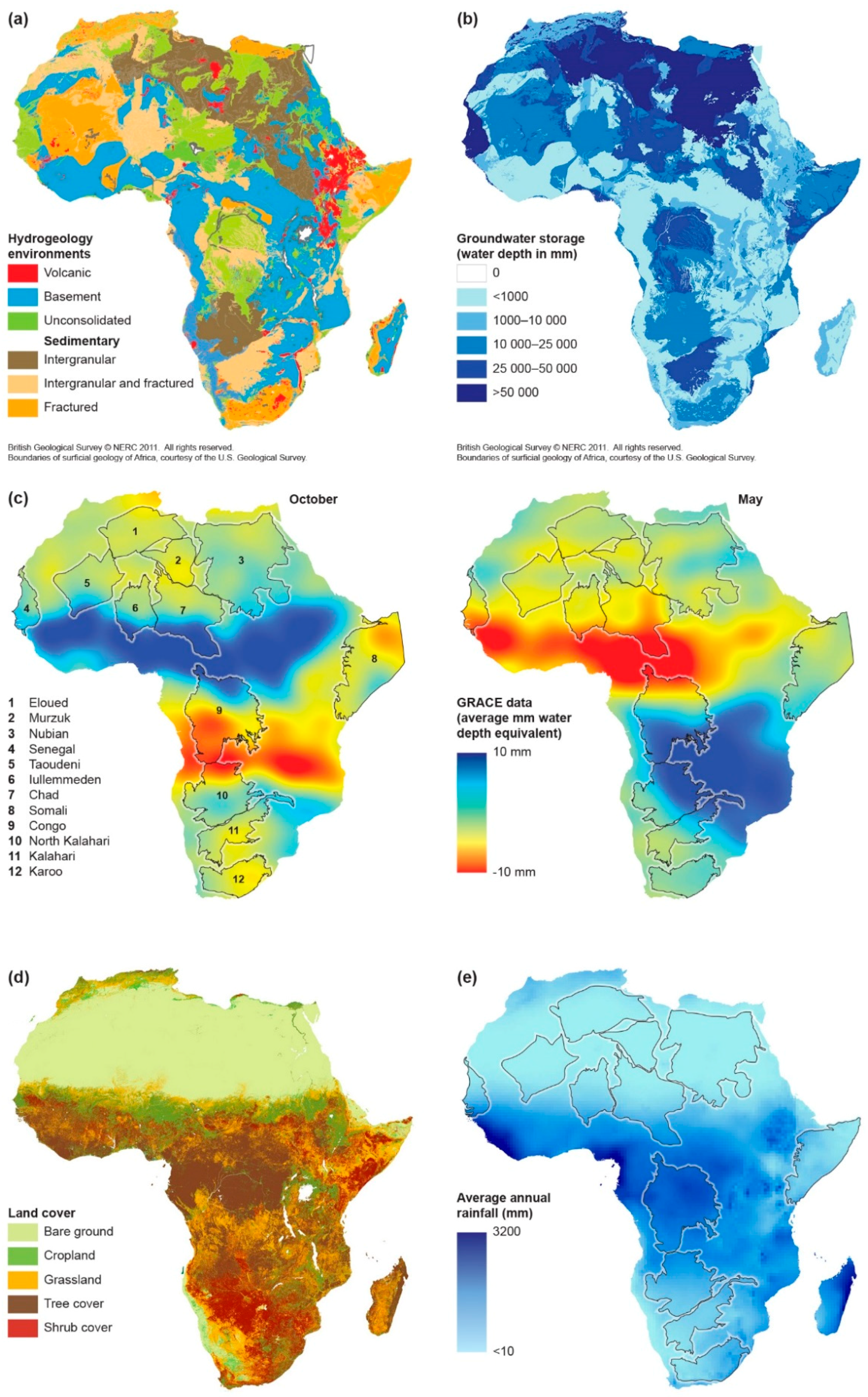
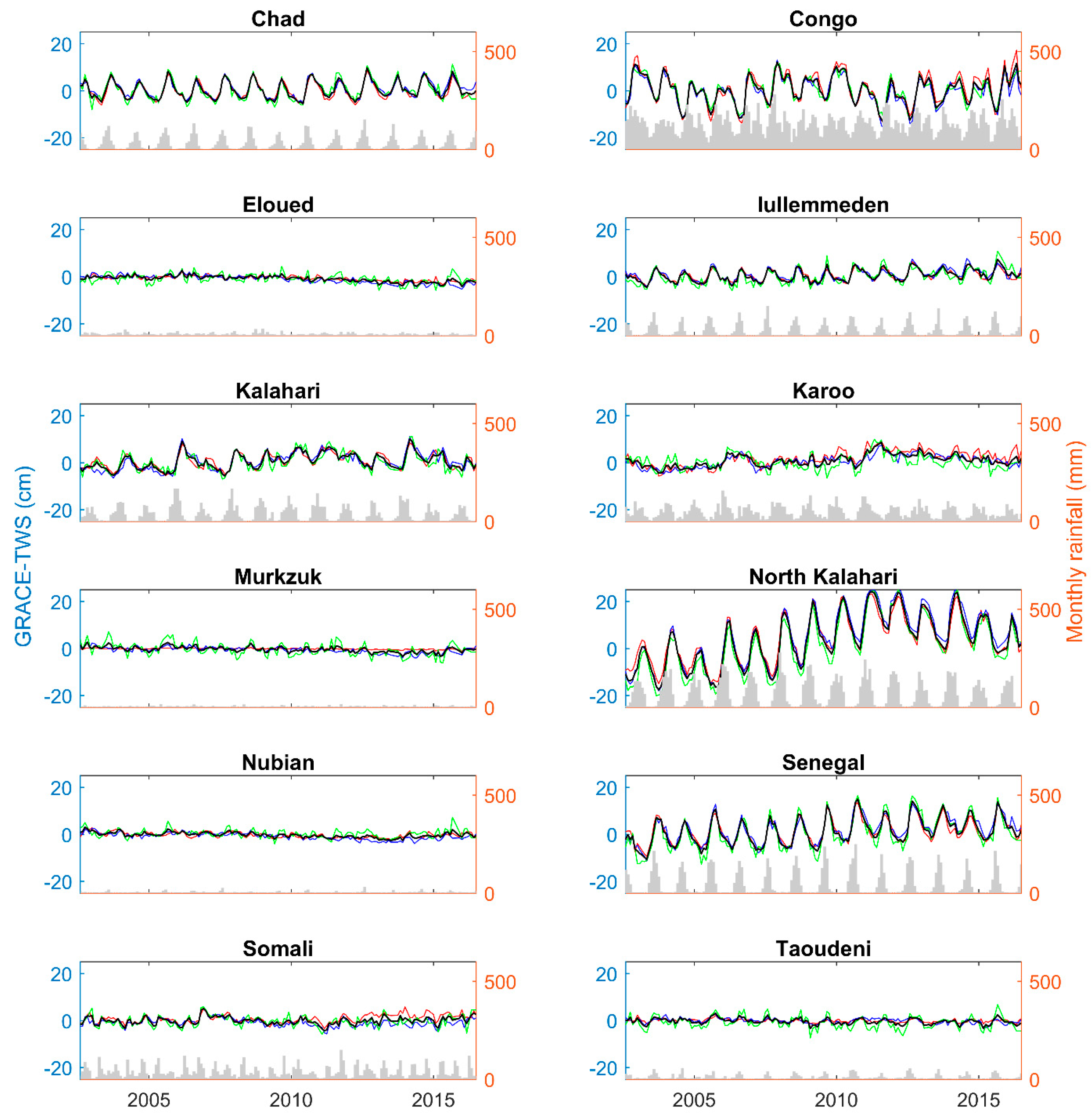
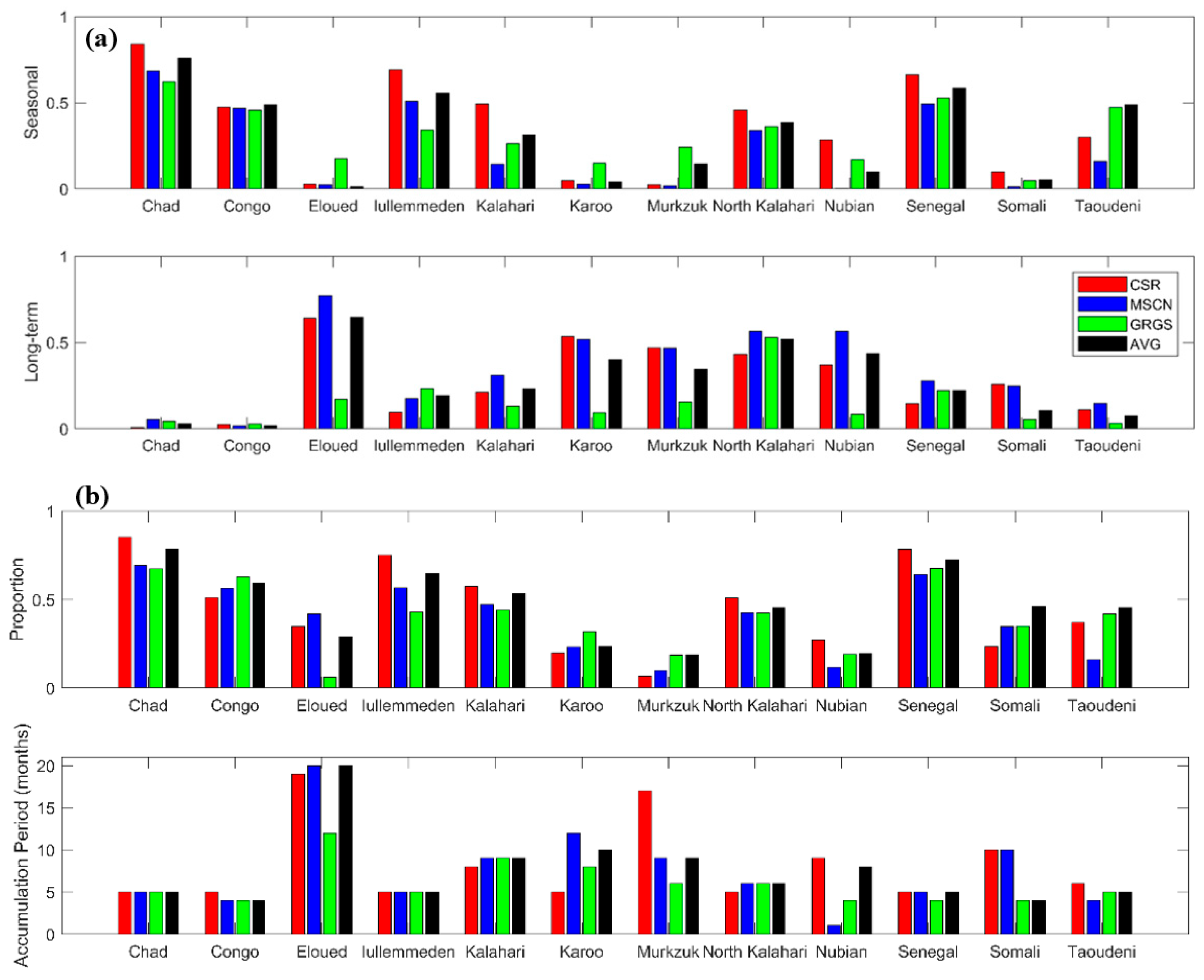
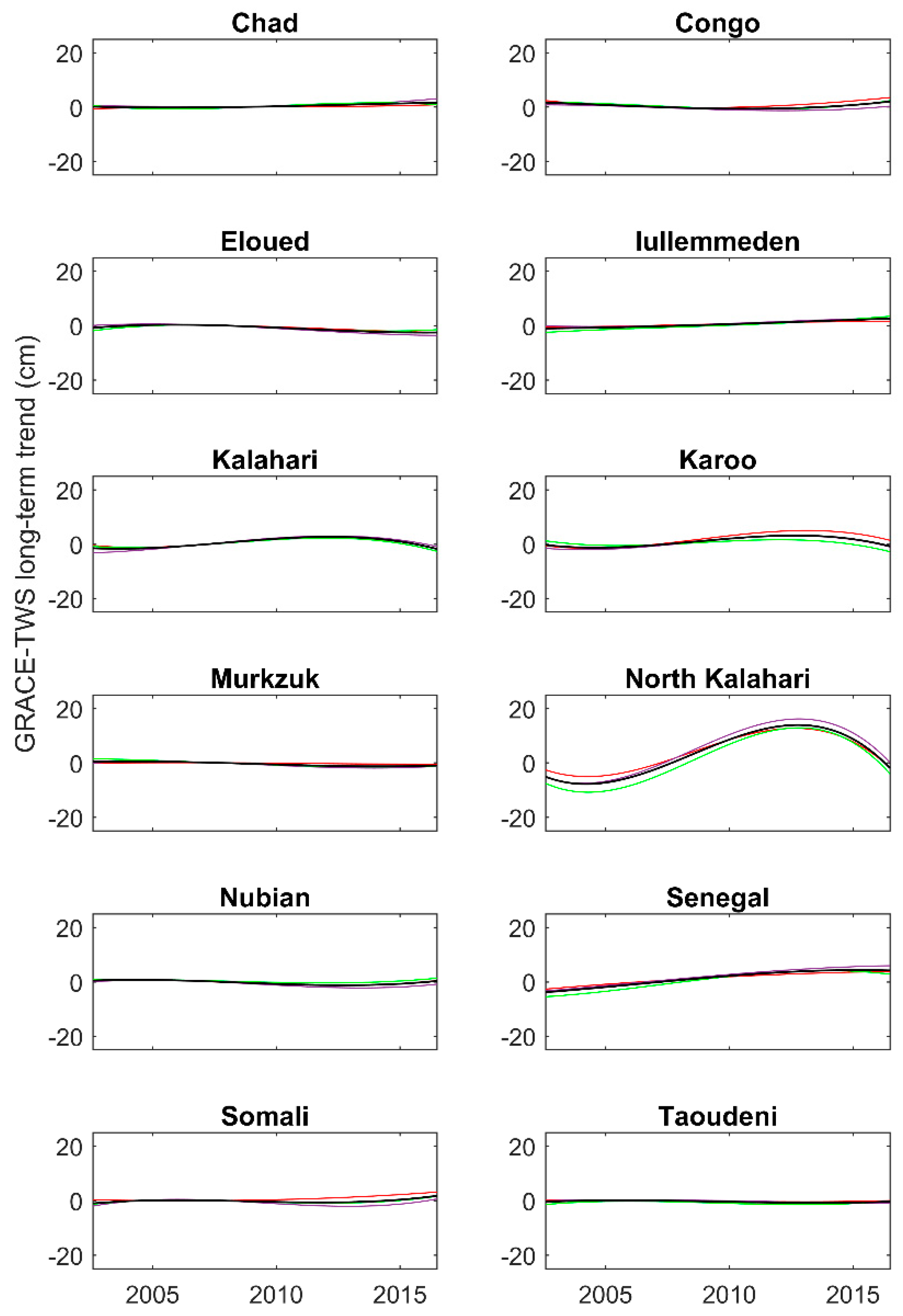
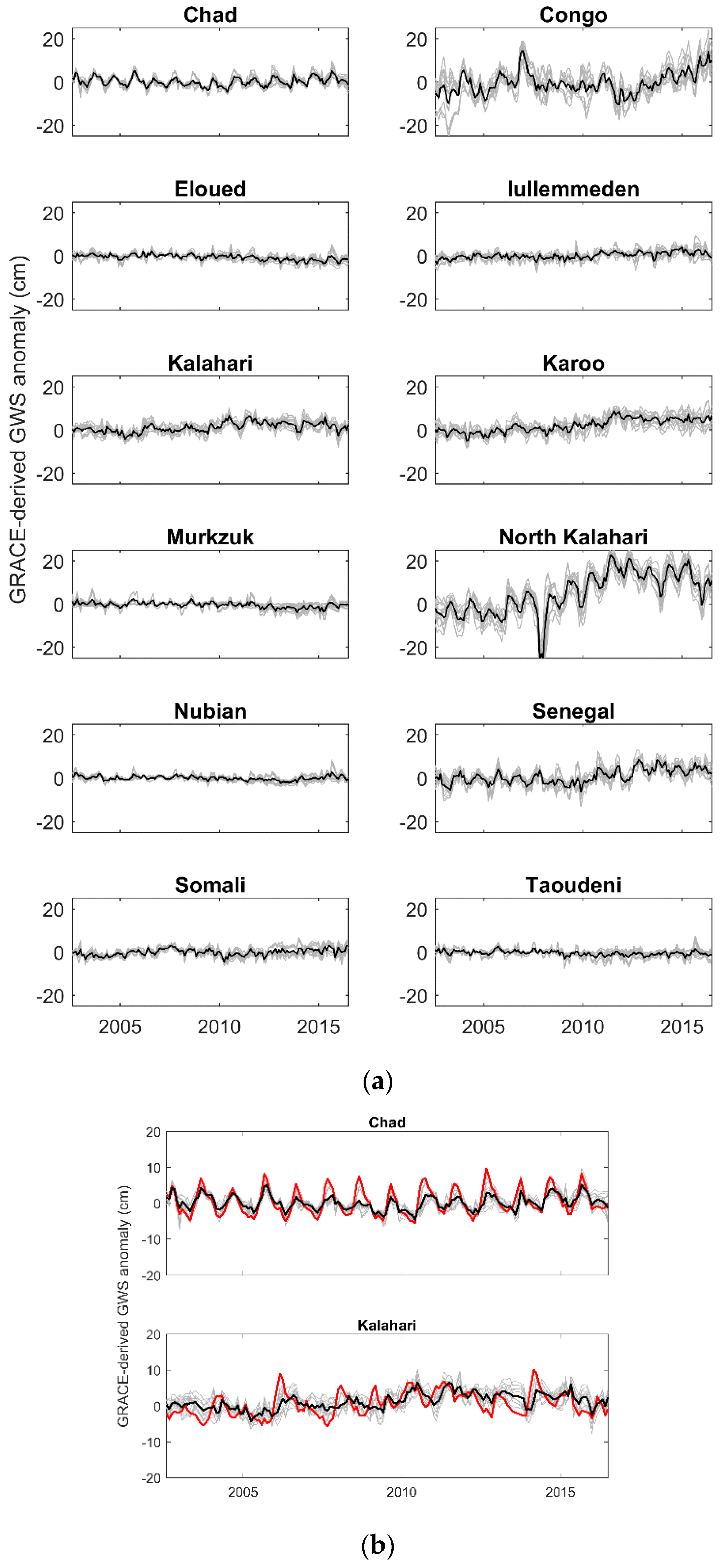
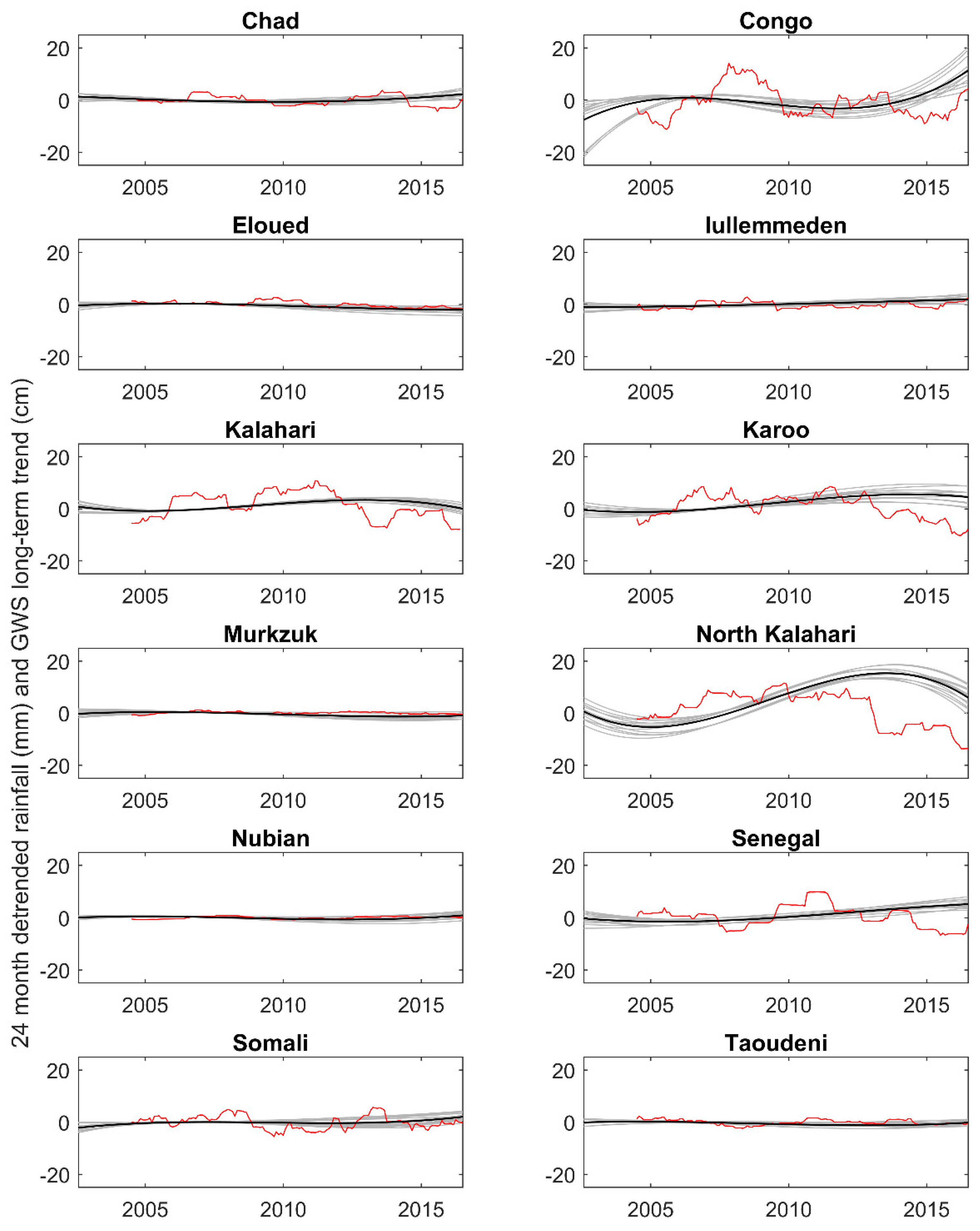

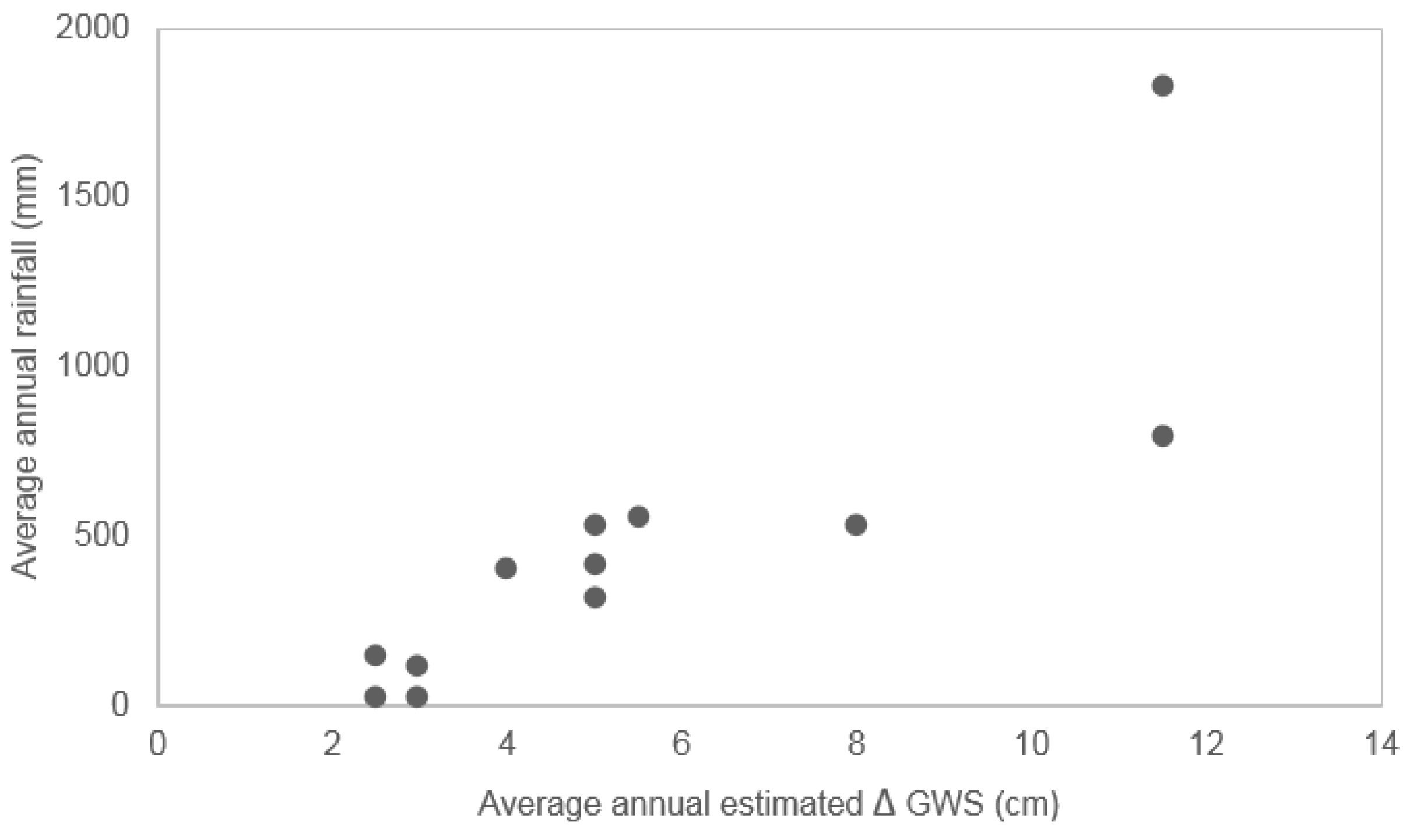
| Aquifer Basin | Area (km2) | Land Cover | Mean Annual Rainfall (cm) | Main Climate Type (Koeppen Classification) | Aridity Class | Range of Ensemble TWS Seasonal Sinusoid (cm) | Range of Ensemble GWS Seasonal Sinusoid (cm) | Linear Rainfall Model of TWS–Accumulation Period (Months) | Linear Rainfall Model of TWS–Proportion of Variance Explained |
|---|---|---|---|---|---|---|---|---|---|
| Eloued | 1,422,000 | bare area | 11.6 | Dry desert | Hyper-arid | 0.41 | 1.24 | 20 | 0.29 |
| Murzuk | 639,000 | bare area | 2.5 | Dry desert | Hyper-arid | 1.28 | 1.47 | 9 | 0.19 |
| Nubian | 2,569,000 | bare area | 2.4 | Dry desert | Hyper-arid | 0.97 | 0.92 | 8 | 0.20 |
| Senegal | 343,000 | cropland; grass | 53.3 | Tropical savannah | Semi-arid | 12.17 | 3.82 | 5 | 0.72 |
| Taoudeni | 1,037,000 | bare area | 14.6 | Dry Desert | Hyper-arid | 2.39 | 1.34 | 5 | 0.45 |
| Iullemmeden | 671,000 | cropland; bare area | 39.9 | Tropical savannah | Arid | 5.28 | 0.94 | 5 | 0.64 |
| Chad | 1,436,000 | cropland; bare area | 41.3 | Tropical savannah | Arid | 8.7 | 3.97 | 5 | 0.78 |
| Somali | 1,164,000 | grassland; shrub | 31.6 | Dry desert | Arid | 1.02 | 0.97 | 4 | 0.46 |
| Congo | 1,659,000 | tree cover | 182.4 | Tropical rainforest | Humid | 11.43 | 3.5 | 4 | 0.59 |
| North Kalahari | 1,161,000 | tree cover; shrub | 79.3 | Tropical Savannah | Semi-arid | 19.23 | 10.02 | 6 | 0.45 |
| Kalahari | 761,000 | shrub; grassland | 52.9 | Temperate grasslands | Semi-arid | 5.25 | 1.71 | 9 | 0.53 |
| Karoo | 814,000 | shrub; grassland | 55.7 | Dry desert | Semi-arid | 1.44 | 1.91 | 10 | 0.23 |
© 2018 by the authors. Licensee MDPI, Basel, Switzerland. This article is an open access article distributed under the terms and conditions of the Creative Commons Attribution (CC BY) license (http://creativecommons.org/licenses/by/4.0/).
Share and Cite
Bonsor, H.C.; Shamsudduha, M.; Marchant, B.P.; MacDonald, A.M.; Taylor, R.G. Seasonal and Decadal Groundwater Changes in African Sedimentary Aquifers Estimated Using GRACE Products and LSMs. Remote Sens. 2018, 10, 904. https://doi.org/10.3390/rs10060904
Bonsor HC, Shamsudduha M, Marchant BP, MacDonald AM, Taylor RG. Seasonal and Decadal Groundwater Changes in African Sedimentary Aquifers Estimated Using GRACE Products and LSMs. Remote Sensing. 2018; 10(6):904. https://doi.org/10.3390/rs10060904
Chicago/Turabian StyleBonsor, H. C., M. Shamsudduha, B. P. Marchant, A. M. MacDonald, and R. G. Taylor. 2018. "Seasonal and Decadal Groundwater Changes in African Sedimentary Aquifers Estimated Using GRACE Products and LSMs" Remote Sensing 10, no. 6: 904. https://doi.org/10.3390/rs10060904
APA StyleBonsor, H. C., Shamsudduha, M., Marchant, B. P., MacDonald, A. M., & Taylor, R. G. (2018). Seasonal and Decadal Groundwater Changes in African Sedimentary Aquifers Estimated Using GRACE Products and LSMs. Remote Sensing, 10(6), 904. https://doi.org/10.3390/rs10060904






